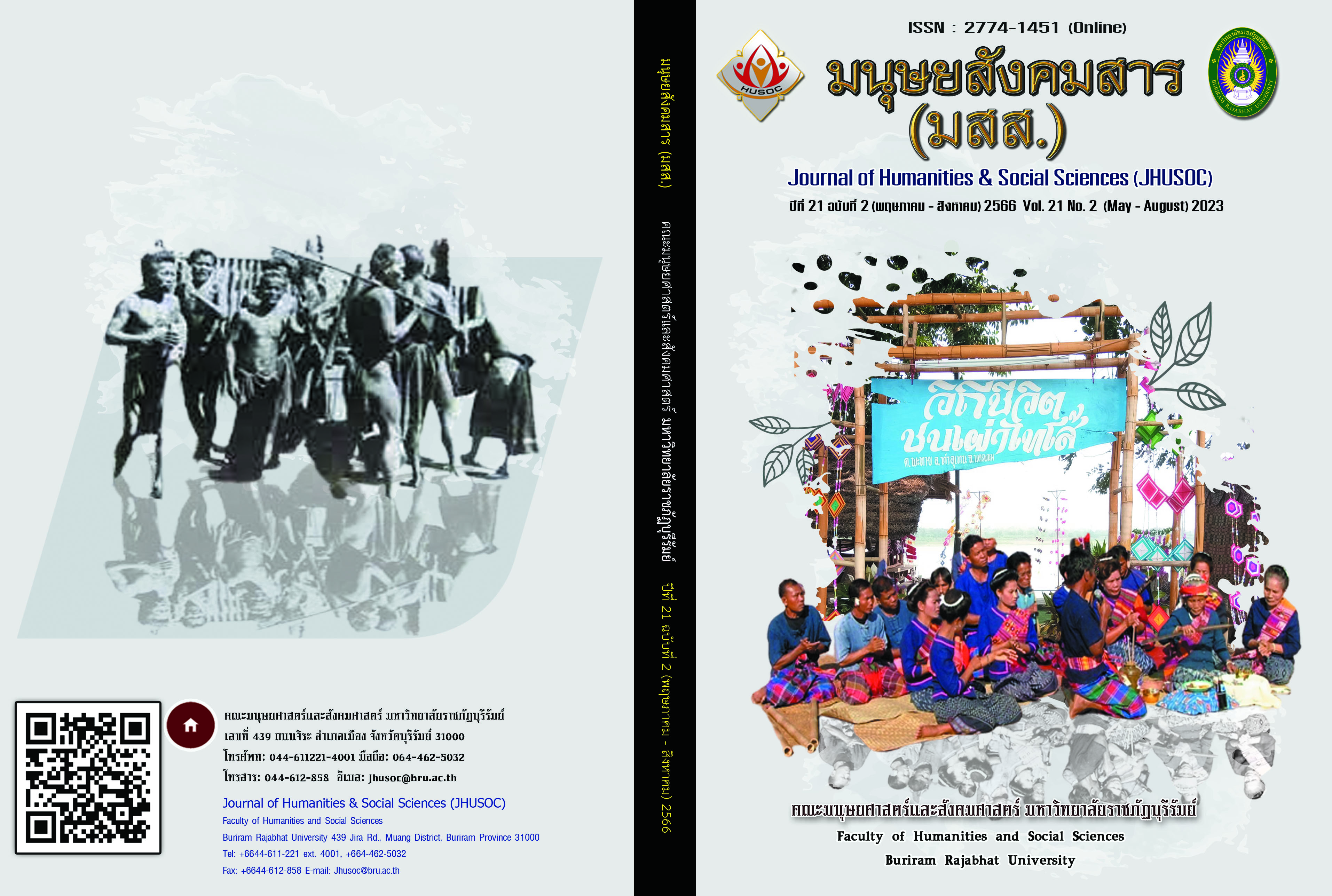The Rise of the Chinese Community before Railways: The Impact of International Politics towards the Chinese Community Establishment in Ubon Ratchathani
Main Article Content
บทคัดย่อ
Thailand’s northeastern region was located in the inner land of mainland Southeast Asia, considered a transcontinental region connected from the east coast and west coast of mainland Southeast Asia before the 19th century. However, there is no evidence of the permanent community established in the Northeastern region until the 19th century that the Thai government needed to survive colonial expansion, Thai government to reform its polity for global economic integration, such as economic reform for all countries as well as train networks to serve the recent development. This encouraged the Chinese people to establish a permanent community in Northeastern Thailand. The foreign treaty with the major powers encouraged the transformed Chinese sojourner to become of the regional development. Some have argued that the Chinese community emerged because of the railway, based on this research it emerged before the time of the development of the railways in Isan. This paper examines the role of modernization policy to encourage the emergence of the Chinese community in Ubon Ratchathani before the construction of the railways, this research is based on historical evidence as well as collective memories to find the origin of the community.
Article Details

อนุญาตภายใต้เงื่อนไข Creative Commons Attribution-NonCommercial 4.0 International License.
เนื้อหาและข้อมูลในบทความที่ลงตีพิมพ์ในวารสารทดสอบระบบ ThaiJo2 ถือเป็นข้อคิดเห็นและความรับผิดชอบของผู้เขียนบทความโดยตรงซึ่งกองบรรณาธิการวารสาร ไม่จำเป็นต้องเห็นด้วย หรือร่วมรับผิดชอบใดๆ
บทความ ข้อมูล เนื้อหา รูปภาพ ฯลฯ ที่ได้รับการตีพิมพ์ในวารสารทดสอบระบบ ThaiJo2 ถือเป็นลิขสิทธิ์ของวารสารทดสอบระบบ ThaiJo2 หากบุคคลหรือหน่วยงานใดต้องการนำทั้งหมดหรือส่วนหนึ่งส่วนใดไปเผยแพร่ต่อหรือเพื่อกระทำการใดๆ จะต้องได้รับอนุญาตเป็นลายลักอักษรจากวารสารทดสอบระบบ ThaiJo2 ก่อนเท่านั้น
เอกสารอ้างอิง
Anonymous. (1886). Monthon Lao Kao [public notice]. King Rama V Ministry of Interior กร 5 ม/59. Thailand National Archive. [in Thai]
Aymonier, É. (2000). Isan travels: Northeast Thailand’s economy in 1883-1884. Bangkok: White Lotus Press.
Burusratanaphand, W. (1995). Chinese identity in Thailand. Southeast Asian Journal of Social Science, 23(1), 43–56. http://www.jstor.org/stable/24492376
Boonmee, L. (2019). The effects of franco-siamese treaties on Ubon Ratchathani urban landscape transformation. Nakhara: Journal of Environmental Design and Planning, 17, 43–54. doi:10.54028/nj2019174354
Chaiwanichaya, S., & Hemanak, H. (2008). The changes of the society in Ubon Ratchathani [Research report]. Ubon Ratchatani: Ubon Ratchathani University. [in Thai]
Chotimanon, C. (2022). The development of the Chinese community in Ubon Ratchathani [interview]. Hua Qiao Gong Huk School
Families and Friends. (1994). Memoir of Khun Mae Inn Kamonlapon (Sritanyarat) for the cremation ceremony [memoir]. Bangkok: Wat Makutkasat. [In Thai]
Kakizaki, I. (2012). Rails of the kingdom: The history of Thai railways. White Lotus Press.
Kietisak, M. (1976). Chinese society in Thailand. Royal Thai Army Academy.
Latham, A J., & Neal, L. (1983). The international market in rice and Wheat, 1868-1914. The Economic History Review, 36(2).
Masaharu, Y. (2003). On the economic history of the Kingdom of Laos from the 14th to 17th centuries from “hinterland state to semi port state”. Bangkok. [in Thai]
Masaharu, Y. (2017). On the relocation of the capital of the Lan Xang Kingdom, Matichon Press.
Owen, N G. (1971). The rice industry of Mainland Southeast Asia 1851-1914. The Siam Society.
Pakahuta, P. (2019). The Buddha images of Ubon Ratchathani style: The historical and local Buddhist arts relation. The Research Institute of North-eastern Art and Culture. [in Thai]
Patanasitubon, N. (2022). The life of the Chinese people during the second world war [interview]. The property and financial secretary of the University of Ubon Ratchathani. [in Thai]
Ratanasin, P., & Son. (1990). The history of Wat Klang Mueng Ubon. Printed for the royal Katina ceremony, his majesty assigned Petchyu Ratanasin and her son to conduct on the ceremony [memoir]. Ubon Ratchatani. [in Thai]
Skinner, G. W. (1962). Chinese society in Thailand an analytical history. Cornell Univ. Pr.
Sng, J., & Phisānbut, P. (2015). A history of the Thai-Chinese / Jeffery Sng and Pimpraphai Bisalputra.
Sritanyarat Family. (1988). The legend of Wat Supatnaram Worahiharn: Printed for the royal Katina ceremony, his majesty assigned Petchyu Ratanasin and her son to carry on the ceremony [memoir]. Ubon Ratchatani. [in Thai]
Sritanyarat, N. (2022). History of Luang Sripoka, The founder of Sritanyarat Family [interview]. Nitipat Sritanyarat’s Lawyer Center.
Sritanyarat, T. (2022). History of Sritanyarat family [interview]. The former local politician.
Tan, B. C. (2016). From immigrants to citizens - changing identities of the Chinese in Malaysia. Ethnicities, Personalities, and Politics in the Ethnic Chinese Worlds, 3–17.
Tanlert, S., Metananon, A. M., & Thecharoongphaisan, N. (2016). History of ethnic Chinese in Mueang Ubon Ratchathani from 1868 to1945 A.D. Humanity and Social Science Journal: Ubon Ratchathani University. [in Thai]
Theerasaswat, S. (2008). History of Isan Chinese (Research report). Center for Research on Plurality in the Mekong Region. [in Thai]
Thongchaiprasit, W. (2022). Chinese community and the Cold War [interviewing]. The Ben Tou Gong Shrine president.
Trang, T. V. (2015). Chinese identity negotiation by Chinese Vietnamese women in Cho Lon community, Ho Chi Minh City, Vietnam through the Use of Chinese at Home. Journal of Mekong Societies, Khon Kaen University. [in Thai]
Wang, G. (2000). The Chinese overseas. Harvard University Press.
Wipacpotchanakit, T. (2003). History of Isan. Bangkok: Thammasat University Press. [in Thai]


